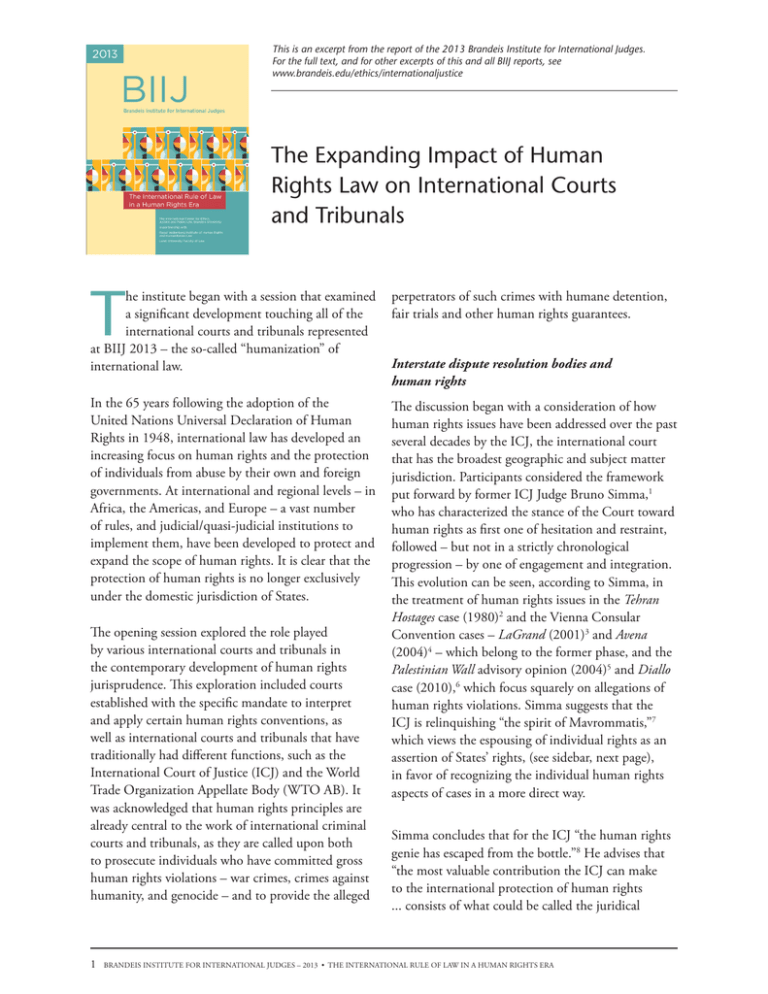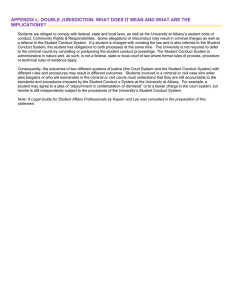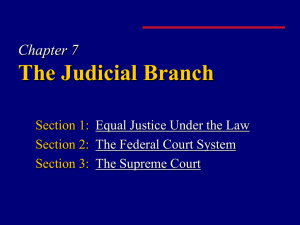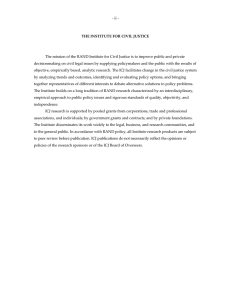Document 14672118
advertisement

This is an excerpt from the report of the 2013 Brandeis Institute for International Judges. For the full text, and for other excerpts of this and all BIIJ reports, see www.brandeis.edu/ethics/internationaljustice The Expanding Impact of Human Rights Law on International Courts and Tribunals T he institute began with a session that examined a significant development touching all of the international courts and tribunals represented at BIIJ 2013 – the so-called “humanization” of international law. perpetrators of such crimes with humane detention, fair trials and other human rights guarantees. In the 65 years following the adoption of the United Nations Universal Declaration of Human Rights in 1948, international law has developed an increasing focus on human rights and the protection of individuals from abuse by their own and foreign governments. At international and regional levels – in Africa, the Americas, and Europe – a vast number of rules, and judicial/quasi-judicial institutions to implement them, have been developed to protect and expand the scope of human rights. It is clear that the protection of human rights is no longer exclusively under the domestic jurisdiction of States. The discussion began with a consideration of how human rights issues have been addressed over the past several decades by the ICJ, the international court that has the broadest geographic and subject matter jurisdiction. Participants considered the framework put forward by former ICJ Judge Bruno Simma,1 who has characterized the stance of the Court toward human rights as first one of hesitation and restraint, followed – but not in a strictly chronological progression – by one of engagement and integration. This evolution can be seen, according to Simma, in the treatment of human rights issues in the Tehran Hostages case (1980)2 and the Vienna Consular Convention cases – LaGrand (2001)3 and Avena (2004)4 – which belong to the former phase, and the Palestinian Wall advisory opinion (2004)5 and Diallo case (2010),6 which focus squarely on allegations of human rights violations. Simma suggests that the ICJ is relinquishing “the spirit of Mavrommatis,”7 which views the espousing of individual rights as an assertion of States’ rights, (see sidebar, next page), in favor of recognizing the individual human rights aspects of cases in a more direct way. The opening session explored the role played by various international courts and tribunals in the contemporary development of human rights jurisprudence. This exploration included courts established with the specific mandate to interpret and apply certain human rights conventions, as well as international courts and tribunals that have traditionally had different functions, such as the International Court of Justice (ICJ) and the World Trade Organization Appellate Body (WTO AB). It was acknowledged that human rights principles are already central to the work of international criminal courts and tribunals, as they are called upon both to prosecute individuals who have committed gross human rights violations – war crimes, crimes against humanity, and genocide – and to provide the alleged 1 Interstate dispute resolution bodies and human rights Simma concludes that for the ICJ “the human rights genie has escaped from the bottle.”8 He advises that “the most valuable contribution the ICJ can make to the international protection of human rights ... consists of what could be called the juridical BRANDEIS INSTITUTE FOR INTERNATIONAL JUDGES – 2013 • THE INTERNATIONAL RULE OF LAW IN A HUMAN RIGHTS ERA Mavrommatis Palestine Concessions, Permanent Court of International Justice 1924, Series A, no. 2, 121 “By taking up the case of one of its subjects and by resorting to diplomatic action or international judicial proceedings on his behalf, a State is in reality asserting its own rights – its right to ensure, in the person of its subjects, respect for the rules of international law. Once a State has taken up a case on behalf of one of its subjects before an international tribunal, in the eyes of the latter the State is sole claimant.”* * As cited in Simma, supra note 2, at 587. ‘mainstreaming’ of human rights, in the sense of integrating this branch of the law into the fabric of both general international law and its various other branches.”9 Some participants were of the opinion that Simma’s framework was overly simplified, attributing too much conservatism to the ICJ in the past and perhaps too much faith in its new human rights sensitivities. The recent Belgium v. Senegal case (2012),10 in which the ICJ considered Senegal’s obligation to prosecute or extradite under the Torture Convention, was described by one judge as a “straightforward human rights case.” It thus shows that the ICJ has embraced the growing trend for courts to directly address human rights considerations. However, in a contemporaneous case, Germany v. Italy (2012),11 the ICJ upheld State immunity in relation to grave crimes committed during World War II, perhaps hailing back to a more classic and State-centered interpretation of international law. The latter case was one that Simma seemed to hope would, instead, set new “priorities between human rights considerations/obligations and other rules of international law, particularly State immunity.”12 Human rights considerations also enter into interstate disputes at the International Tribunal for the Law of 2 the Sea (ITLOS). It was pointed out that the drafters of the Law of the Sea Convention made provision for the prompt release of fishing crews when ships are seized for suspected violations, against the posting of bond that serves as a guarantee for any fines that may be levied in the future. The rights of fishermen are thereby protected, keeping them from detention in potentially unacceptable conditions, without prejudging the substance of the dispute.13 Finally, a participant noted that trade disputes are increasingly viewed through a human rights lens at the WTO Appellate Body. For example, one State’s right to protect its youth from smoking may come into conflict with another State’s right to export tobacco. Similarly, a dispute over tuna can be conceptualized as the right of consumers to know how the tuna they eat was caught, against the right of a country to export canned tuna. International criminal tribunals and human rights The discussion then proceeded to the dual role that human rights law plays in the proceedings of international criminal courts and tribunals. Human rights principles entitle every accused person to due process of law, which guarantees a fair trial without undue delays, and safeguards the integrity of the entire criminal proceeding. At the same time, a criminal proceeding seeks to promote the human rights of those who claim to have suffered from the acts of the accused. These two uses of human rights law have been termed their “shield” and “sword” functions.14 In a recent article, former European Court of Human Rights (ECtHR) Judge Françoise Tulkens noted that this double function creates a paradox in which human rights assume both a defensive and offensive role, “a role of both neutralizing and triggering the application of criminal law.”15 BIIJ participants generally agreed that there are multiple, and at times conflicting, interests to be weighed in relation to an international criminal proceeding. In addition to considering the rights BRANDEIS INSTITUTE FOR INTERNATIONAL JUDGES – 2013 • THE INTERNATIONAL RULE OF LAW IN A HUMAN RIGHTS ERA of the accused and victims in a case, the following must also be taken into account: the protection of witnesses associated with the proceeding; the interest of the international criminal tribunal itself in effectively discharging its judicial role; and the international community’s desire to see a fair and expeditious trial, the end of impunity, and the deterrence of future crimes. One judge contested the notion that both the accused and victims in a case have “rights” in the same sense. While the rights of accused persons are enshrined in multiple human rights instruments, he characterized victims as having “interests” rather than rights per se. He questioned, in particular, the idea that a victim has the right to see a perpetrator brought to justice, noting that it is instead the right to reparation that is widely accepted. He also asked an important question for contemporary international criminal justice: to what reparations is an accused entitled if his or her rights have been egregiously violated, as in the case of unlawful arrest or detention? This is not an entirely theoretical question. In the early years of the International Criminal Tribunal for the former Yugoslavia (ICTY), several persons accused of crimes in the Balkans were arrested under questionable circumstances. One participant reminded the group of the treatment of Dragan Nikolić, a Serbian commander charged with war crimes. He was tracked down by bounty hunters, knocked unconscious, bound hand and foot, and then turned over to United Nations forces who transported him to The Hague. Although Nikolić hoped this unlawful treatment might lead to a dismissal of his case, the remedy was instead a reduction of sentence following his conviction.16 The circumstances of Nikolić’s arrest led to a lively exchange about the rights of the accused. A former prosecutor said that criminal tribunals should not condone any illegality in the arrest of a defendant; they are “in many ways human rights courts and should not be involved in the violations of human rights,” he declared. Another noted, “there may have been a place in the Wild West for bounty 3 hunting, but not in the 20th century.” Moreover, this same judge was troubled by what he saw as the confusion of substance and procedure in the Nikolić case, noting that an irregularity in his arrest should not have influenced the determination of his sentence. A criminal judge disagreed, explaining that as a human rights violation entails the right to a remedy, a reduction of Nikolić’s sentence was the logical remedy following his conviction. It was noted that the Extraordinary Chambers in the Courts of Cambodia (ECCC) had a similar situation with the illegal detention of an accused, and the Court followed the same reasoning as the ICTY, reducing the sentence of the accused upon conviction. The group then turned to the interests of victims in criminal cases. First, a conceptual challenge had to be addressed – can a victim really be considered as having the “right” to see a perpetrator prosecuted? A leading judgment on this question came from the ECtHR in X and Y v. The Netherlands (1985),17 where it was ruled that the impossibility of instituting criminal proceedings against the perpetrator of sexual assault on a minor with a mental disability breached the victim’s right to respect for private and family life (Article 8 of the European Convention).18 One BIIJ participant clarified that any such right is only to see an alleged perpetrator prosecuted, not convicted. Participants brought a variety of institutional perspectives to bear on how victims avail themselves of this right. Both the ECCC and the International Criminal Court (ICC) have formal provisions for the participation of victims in criminal proceedings. One judge noted that whereas the rights of accused persons at the ECCC have already “crystallized,” the rights of victims are instead solidified only upon the conviction of an accused. At that point, they may ask for compensation. Victims may also come forward at an earlier stage and request an investigation. A note of caution was added to this description of victims’ rights at the ECCC. A court can easily become overwhelmed when dispensing justice to satisfy not only its international mandate – that is, to prosecute and punish perpetrators – but also the demands of individual victims. This is especially true BRANDEIS INSTITUTE FOR INTERNATIONAL JUDGES – 2013 • THE INTERNATIONAL RULE OF LAW IN A HUMAN RIGHTS ERA when resources are scarce. Another judge opined that criminal procedure is perhaps best understood “from the view of social interests,” adding that “individual benefit is secondary or even incidental to the process.” It was then noted that victim participation at the ICC has been taken to an even higher level; one judge went so far as to suggest that “victims are the masters.” The court is very careful to confirm that individuals have been truly affected by the acts of a particular accused before being granted the status of victim. Their interests are the mandate of the Trust Fund for Victims, which works with affected communities – inter alia to restore medical and educational resources and human resilience – even before there is a conviction. Once an accused is found guilty, reparations for victims can be determined. Although the ICC enjoys a more stable financial situation than the ECCC, it is already clear that making reparations to victims – especially as the numbers increase with each successive ICC case – will constitute a daunting challenge. This discussion of victims’ rights was then interrupted by another conceptual challenge: How can a court classify certain individuals as “victims” in a case before an accused has actually been convicted? Is that not “putting the cart before the horse”? One criminal judge suggested that another term be coined, perhaps “putative victim,” so that the “uncrystallized” rights of that person can be examined and determined. It seemed reasonable to that judge that a putative victim have at least the right to see a fair prosecution of the accused. Not everyone agreed, however, with the notion that the status of “victim” can only be definitively granted after a conviction. One participant pointed out that there are persons who are clearly victims of a regime even if individual criminals have not yet been identified. Most of the Cambodian population, for example, was targeted by Khmer Rouge activities, and there is ample evidence to show this even without convictions. The question to be examined through trials is whether particular individuals have criminal responsibility for those activities. “What we 4 need,” another participant suggested, “is a new term to identify survivors of crimes against humanity as individuals and groups, as opposed to victims in a criminal context.” Over the past 15 years, the Inter-American Court of Human Rights (IACtHR) has had occasion to rule on various issues related to such proceedings at the national level. Rulings of the Court are mandatory for the States that have accepted its jurisdiction. When there have been serious violations of human rights in States that are party to the American Convention on Human Rights, those States then have the obligation to investigate and prosecute the individuals deemed responsible. This obligation has frequently conflicted, however, with national amnesty laws. When the IACtHR has found enough evidence, it has directed national judiciaries through its decisions to open multiple criminal cases, some of them involving the prosecution of former Heads of State. The regional court then monitors and supervises compliance with its decisions – sometimes holding hearings to receive public feedback – until there has been full implementation. This interaction between the IACtHR and its Member States has resulted in stronger criminal courts at the national level and enhanced dialogue between the regional and national courts.19 The African Court on Human and Peoples’ Rights (ACtHPR) is a relative newcomer and has not yet had to rule on criminal proceedings in member States. But it is already clear that questions of rights in this context are bound to arise.20 Indeed, the ACtHPR is already receiving inquiries about how a finding of criminality in the investigation of a human rights violation will be handled. The involvement of the Inter-American Court in monitoring criminal proceedings at the national level can serve as a guide, one judge declared. “When human rights are violated, so many other blisters inevitably pop up. And part of that will be the question of the rights or interests of the victim.” The judge added that the frustration of putative victims without a means of redress may lead to many more problems in the future, at both the individual and societal level. “This is one of the reasons that it is important to always BRANDEIS INSTITUTE FOR INTERNATIONAL JUDGES – 2013 • THE INTERNATIONAL RULE OF LAW IN A HUMAN RIGHTS ERA look at the rights of the victim and ensure that prosecution takes place in an effective manner.” The question of fragmentation Recognition of the increased inclusion of human rights issues across all categories of international courts naturally led to a discussion of the possible fragmentation of norms. Several judges noted the spontaneous judicial dialogue that has occurred among disparate courts. For example, in Germany v. Italy,21 the ICJ took the same approach as that followed by the ECtHR on State immunity for acts committed by its armed forces on the territory of another State. In Belgium v. Senegal, the ICJ also refrained from commenting on the ECOWAS Court’s ruling that the principle of nullum crimen sine lege precluded Senegal from trying former Chadian dictator Hissène Habré under Senegalese laws. 22 In determining crimes against humanity, the Supreme Court of Peru applied the same standards established by the IACtHR, following the regional court’s ruling on the Barrios Altos v. Peru case (2001).23 And the ICTR was very careful to cite international and regional jurisprudence instead of national jurisprudence in its judgments in order to build up a common body of human rights law. A judge with experience in both criminal and interstate dispute courts suggested that lawyers before international courts should be encouraged to make reference to international jurisprudence in their advocacy. “The simple development of habits in this area goes a long way to minimize the risk of fragmentation.” Other participants were not so optimistic that the fragmentation of human rights norms could be avoided. One pointed out that the ECtHR is not always in line with UN treaty bodies, with “one interpretation coming from Strasbourg and another from Geneva.” And now that the European Court of Justice is starting to develop its own human rights jurisprudence, there is the worry that the European bodies might diverge from one another as well. “We are at a turning point in relation to human rights protections,” this judge continued. “In the early 1990’s, there was enthusiasm for human rights not only in Europe but in other parts of the world. But now States are more reluctant and want 5 a more limited interpretation of their human rights obligations under different treaties.” The session ended with reflections on what happens to human rights norms when there is an attempt to spread them universally. Several participants believed that, given wide disparities in cultural and social practices across the globe, the best one can expect from the international human rights system is the implementation of “the lowest common denominator.” The notion that States should be afforded a “margin of appreciation” – the doctrine developed through ECtHR case law that allows a local interpretation of international norms that takes into account cultural, historic and philosophical differences – further complicates the establishment of universal standards. BIIJ participants acknowledged that, in general, human rights standards tend to be higher when extended over geographically limited areas. As one judge expressed it, “If we leave human rights interpretation solely to international bodies, the result will be lower standards.” This idea notwithstanding, another judge observed that regional human rights bodies often set higher standards than those found at the level of their own Member States, despite the fact that the protection of human rights remains the duty of individual countries. He concluded, “It is an illusion to believe that the human rights standards found at regional levels can be applied everywhere. It would take a long time to get there.” The opening session of BIIJ 2013 set the stage for subsequent discussions on the growing influence of human rights on legal thinking and practice across the globe, as well as on the work of international judges and their institutions. What became clear over the course of the discussion was that international courts and tribunals are not merely the beneficiaries of an increased worldwide awareness and appreciation of human rights. They are themselves important actors in the development and articulation of the human rights era that we live in today. Their influence may perhaps be best seen in the everincreasing influence that these institutions exert over legal practice and procedures in the national sphere. BRANDEIS INSTITUTE FOR INTERNATIONAL JUDGES – 2013 • THE INTERNATIONAL RULE OF LAW IN A HUMAN RIGHTS ERA Notes 1. Bruno Simma, Human Rights Before the International Court of Justice: Community Interest Coming to Life?, in 1 Coexistence Cooperation and Solidarity: Liber Amicorum Rüdiger Wolfrum 577-603 (Holger P. Hestermeyer et al. eds., 2012). 2. United States Diplomatic and Consular Staff in Tehran (U.S. v. Iran), ICJ Judgment (24 May 1980). 3. LaGrand (Germany v. U.S.), ICJ Judgment (27 June 2001). 4. Avena and other Mexican Nationals (Mexico. v. U.S.), ICJ Judgment (31 Mar 2004). 5. Legal Consequences of the Construction of a Wall in the Occupied Palestinian Territory, ICJ Advisory Opinion (9 July 2004). 6. Ahmadou Sadio Diallo (Republic of Guinea v. Dem. Rep. Congo), ICJ Judgment (30 Nov. 2010). 7. Simma, supra note 2, at 587. 8. Id. at 598. 9. Id. at 601. 10. Questions Relating to the Obligation to Prosecute or Extradite (Belgium v. Senegal), ICJ Judgment (20 July 2012). 11. Jurisdictional Immunities of the State (Germany v. Italy: Greece intervening), ICJ Judgment (3 Feb. 2012). 12. Simma, supra note 2, at 603. 13. The provisional measures ordered in November 2013 by ITLOS for the release of the crew of a Greenpeace vessel seized in the waters of the Russian Federation is the most recent example of these kinds of protections. See the Arctic Sunrise case (Kingdom of The Neth. v. Russ. Fed’n), ITLOS Case No. 22 (Order of 22 Nov. 2013). 16. Prosecutor v. Nikolić, Case No. IT-94-2-A, Int’l Crim. Trib. for the former Yugoslavia Judgment on Sentencing Appeal (4 Feb 2005). 17. X and Y v. Netherlands, App. No. 8978/80 Eur. Ct. H.R. Judgment (26 Mar. 1985). 18. Tulkens, supra note 15, at 584. 19. In August 2013, the IACtHR issued its first judgment in favor of a living survivor of Pinochet era abuses, finding Chile in violation of its obligations to investigate and remedy the arbitrary detention and torture of a man who was left permanently disabled by the torture he suffered at the hands of the government in the 1970s. Chile was ordered to pay the victim reparations. See Garcia Lucero et. al. v. Chile, Preliminary Objections, Merits, Reparations and Costs, Inter-Am. Ct. H.R. Judgment (ser. C) No. 627 (28 August 2013). 20. The ACtHPR did, however, order provisional measures concerning the conditions of detention of Saif Al-Islam Gadaffi by the National Transitional Council of Libya, pending his criminal trial. See In the Matter of African Commission on Human and Peoples’ Rights v. Libya, App. No. 002/2013, Afr. Ct. Hum. & Peoples’ Rts. Provisional Measures (15 Mar. 2013). 21. Jurisdictional Immunities of the State (Germany v. Italy: Greece intervening), supra note 12. 22. Questions Relating to the Obligation to Prosecute or Extradite (Belgium v. Senegal), supra note 11; see also Hissène Habré v. Senegal, Decision No. ECW/CCJ/JUD/06/10, Ct. of Justice of the Econ. Union of West Afr. States (18 Nov. 2010) [unofficial translation of the French original]. 23. See Barrios Altos v. Peru, Inter-Am Ct. H.R. Judgment (Ser. C) No. 87 (30 Nov. 2001). 14. Françoise Tulkens, The Paradoxical Relationship Between Criminal Law and Human Rights, J. Int’l Crim. Just. (2011) 9 (3): 577-595. 15. Id. at 579. INTERNATIONAL CENTER for ETHICS, JUSTICE and PUBLIC LIFE Brandeis University Brandeis University MS 086 P.O. Box 549110 Waltham, MA 02454-9110 USA (781) 736-8577 www.brandeis.edu/ethics 6 BRANDEIS INSTITUTE FOR INTERNATIONAL JUDGES – 2013 • THE INTERNATIONAL RULE OF LAW IN A HUMAN RIGHTS ERA



